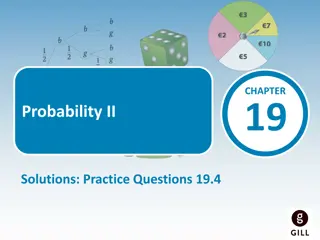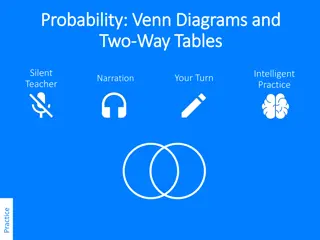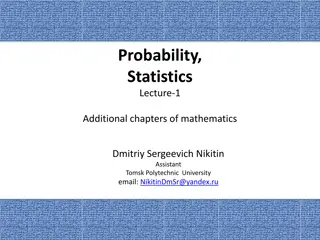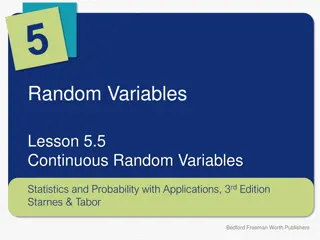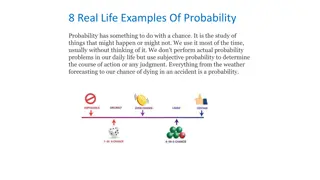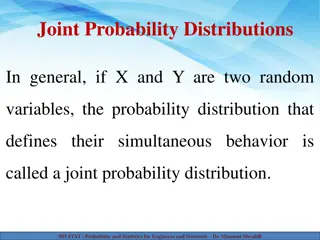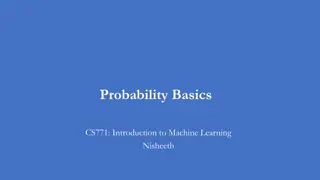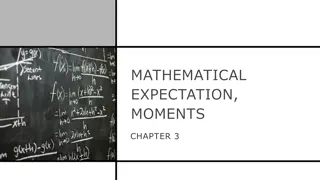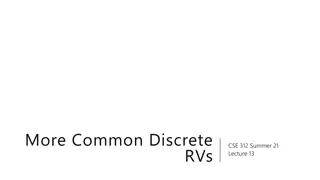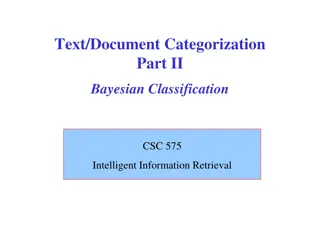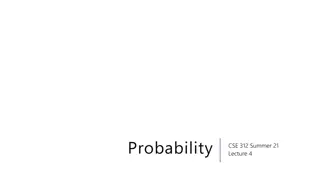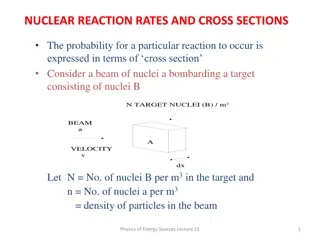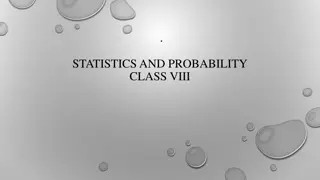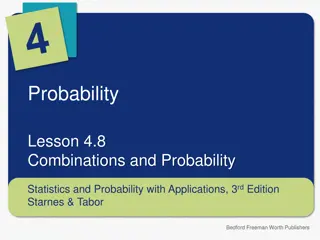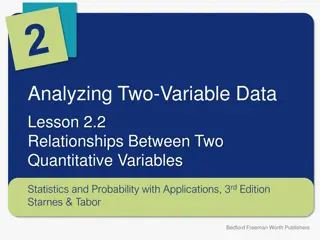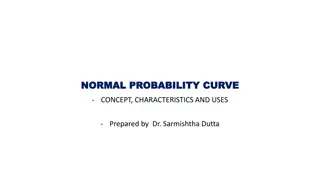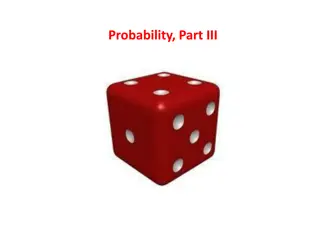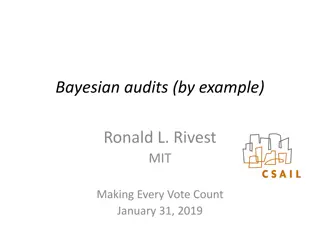Understanding Probability and Randomness
Explore the concepts of randomness, probability, and simulation in this informative lesson. Learn how to interpret probability as a long-run relative frequency, dispel common myths about randomness, and use simulation to model chance behavior. Delve into the idea that chance behavior is unpredictable in the short run but follows a regular pattern in the long run. Discover the significance of outcomes with probabilities of 0, 1, and 0.5, and understand the Law of Large Numbers. Challenge your understanding with practical problems related to interpreting probability in real-world scenarios.
Download Presentation

Please find below an Image/Link to download the presentation.
The content on the website is provided AS IS for your information and personal use only. It may not be sold, licensed, or shared on other websites without obtaining consent from the author. Download presentation by click this link. If you encounter any issues during the download, it is possible that the publisher has removed the file from their server.
E N D
Presentation Transcript
Probability Lesson 4.1 Randomness, Probability, and Simulation Statistics and Probability with Applications, 3rdEdition Starnes & Tabor Bedford Freeman Worth Publishers
Randomness, Probability, and Simulation Learning Targets After this lesson, you should be able to: Interpret probability as a long-run relative frequency. Dispel common myths about randomness. Use simulation to model chance behavior. Statistics and Probability with Applications, 3rdEdition 2 2
Randomness, Probability, and Simulation Chance is all around us. The mathematics of chance behavior is called probability. Chance behavior is unpredictable in the short run, but has a regular and predictable pattern in the long run. Probability The probability of any outcome of a chance process is a number between 0 and 1 that describes the proportion of times the outcome would occur in a very large number of repetitions. Statistics and Probability with Applications, 3rdEdition 3 3
Randomness, Probability, and Simulation Outcomes that never occur have probability 0. An outcome that happens on every repetition has probability 1. An outcome that happens half the time in a very long series of trials has probability 0.5. The fact that the proportion of heads in many tosses of a coin eventually closes in on 0.5 is guaranteed by the law of large numbers. Law of Large Numbers The law of large numbers says that if we observe more and more repetitions of any chance process, the proportion of times that a specific outcome occurs approaches its probability. Statistics and Probability with Applications, 3rd Edition 4 4
Was the moon landing real? Was the moon landing real? Interpreting probability Interpreting probability PROBLEM: According to The Book of Odds, the probability that a randomly selected U.S. adult believes the government staged or faked the Apollo moon landing in July 1969 is 0.06. (a) Explain what probability 0.06 means in this setting. If you take a very large random sample of U.S. adults, about 6% of them will be people who believe the government staged or faked the Apollo moon landing. (b) Does this probability say that if 100 U.S. adults are chosen at random, exactly 6 of them believe the government staged or faked the Apollo moon landing? Explain. No. Probability describes what happens in many, many repetitions (way more than 100) of a chance process. We would expect to get about 6 people who believe the government staged or faked the Apollo moon landing in a random sample of 100 U.S. adults. Statistics and Probability with Applications, 3rd Edition 5 5
Due for a win? Due for a win? Beware the law of averages Beware the law of averages PROBLEM: A player is playing the game of craps and needs to roll a sum of 8 on two fair dice to win the game. The player then rolls a sum of 6, 7, 10, 10, and 6 on the next five consecutive rolls. A spectator yells You re due for a win! Explain why the spectator is wrong. The spectator s claim is based on the law of averages. This player is just as likely to roll an 8 on this roll as she was on any previous roll (and this probability is 5/36 0.139). Statistics and Probability with Applications, 3rd Edition 6 6
Randomness, Probability, and Simulation We can model chance behavior and estimate probabilities with a simulation. Simulation Simulation is the imitation of chance behavior, based on a model that accurately reflects the situation. How to Perform a Simulation STATE: Ask a question about some chance process. PLAN: Describe how to use a chance device to imitate one repetition of the process. Tell what you will record at the end of each repetition. DO: Perform many repetitions. CONCLUDE: Use the results of your simulation to help answer the question. Statistics and Probability with Applications, 3rd Edition 7 7
Can you roll them all? Can you roll them all? Simulations with technology Simulations with technology PROBLEM: A local charity is running a casino-night fundraiser. One game, called Roll them all, will pay out $5 on a $2 bet if a player can roll ten fair dice and have all six numbers show face up. Design and carry out a simulation to estimate the probability that all of the numbers 1-6 will show face up when rolling 10 dice. If this game is played 1000 times, should the local charity expect to make money on this game? STATE: What s the probability that the numbers 1 through 6 will show face up when rolling 10 dice? PLAN: Use randInt(1,6,10) to simulate rolling 10 dice. On older calculators, use randInt(1,6) and press Enter 10 times to see all ten rolls. Record whether or not all six numbers were shown in the 10 rolls. Repeat these two steps 50 times. Statistics and Probability with Applications, 3rd Edition 8 8
Can you roll them all? Can you roll them all? Simulations with technology Simulations with technology DO: Rep 1: 6 4 2 6 6 1 5 2 2 1 No Rep 2: 6 6 2 1 6 6 2 4 1 2 No Rep 3: 4 2 4 2 2 3 3 4 5 2 No Rep 4: 6 5 4 2 5 1 1 1 2 2 No Rep 5: 1 2 1 5 1 5 4 6 1 3 Yes CONCLUDE: In one set of 50 repetitions of the simulation, all six numbers were shown in 15 of the trials. The estimated probability that all six numbers are shown when rolling 10 dice is approximately 15/50 = 0.30. In 1000 rolls, the charity can expect about 300 winners and 700 losers. They would gain $2 from the bets on all 1000 games, for a total of $2000, and they would have to pay $5 to each of the 300 winners, for a total loss of $1500. The charity can expect to make a profit of about $500 after 1000 games have been played. Statistics and Probability with Applications, 3rd Edition 9 9
LESSON APP 4.1 Will the train arrive on time? New Jersey Transit claims that its 8:00 a.m. train from Princeton to New York has probability 0.9 of arriving on time. Assume for now that this claim is true. 1. Explain what probability 0.9 means in this setting. 2. The 8:00 a.m. train has arrived on time 5 days in a row. What s the probability that it will arrive on time tomorrow? Explain. Statistics and Probability with Applications, 3rd Edition 10 10
LESSON APP 4.1 Will the train arrive on time? New Jersey Transit claims that its 8:00 a.m. train from Princeton to New York has probability 0.9 of arriving on time. Assume for now that this claim is true. 3. A businessman takes the 8:00 a.m. train to work on 20 days in a month. He is surprised when the train arrives late in New York on 3 of the 20 days. Should he be surprised? Describe how you would carry out a simulation to estimate the probability that the train would arrive late on 3 or more of 20 days if New Jersey Transit s claim is true. Do not perform the simulation. Statistics and Probability with Applications, 3rd Edition 11 11
LESSON APP 4.1 Will the train arrive on time? 4. The dotplot shows the number of days on which the train arrived late in 100 repetitions of the simulation. What is the resulting estimate of the probability described in Question 3? Should the businessman be surprised? Statistics and Probability with Applications, 3rd Edition 12 12
Randomness, Probability, and Simulation Learning Targets After this lesson, you should be able to: Interpret probability as a long-run relative frequency. Dispel common myths about randomness. Use simulation to model chance behavior. Statistics and Probability with Applications, 3rd Edition 13 13





















